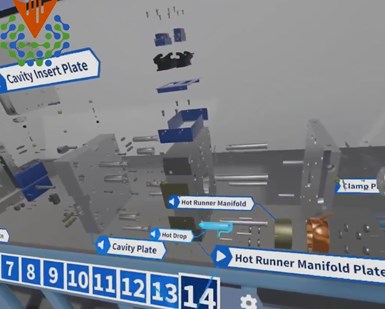
Virtual reality training addresses the skills gap, offering immersive, cost-effective learning experiences.
Source: Kruse Analysis
I chatted with Torsten Kruse of Kruse Analysis and Training about using virtual reality in mold design training, which has been under development since I spoke with him and Rick Finnie of M.R. Mold at the MoldMaking Conference in 2023. But more impressive is the demo he created to show you how it works! See link in sidebar below.
Q: Why are precision, speed, and innovation crucial in mold design and injection molding?
A: Precision, speed, and innovation are vital in mold design and injection molding to ensure high-quality products, minimize production time, and stay competitive in the market.
Q: How does VR technology contribute to training in mold design and production?
A: VR technology provides an interactive learning journey, simulating authentic molding scenarios and allowing hands-on experience without the risks and costs associated with physical experimentation. This approach is particularly beneficial for learning the precision and quality required in moldmaking.
Q: How does VR-based training differ from traditional engineering education?
A: Unlike traditional engineering education, which emphasizes theoretical knowledge and passive learning, VR-based training immerses learners in a dynamic virtual space where they can engage with 3D models and observe their decisions on mold design. This active learning strategy enhances understanding and problem-solving skills.
Q: Why is the integration of VR into eLearning important for the moldmaking industry?
A: The integration of VR into eLearning addresses the pressing need for adept engineers, preparing the workforce for technological shifts. It also attracts young talent by merging cutting-edge technology with practical experience, resonating with the digital-native demographic.
Q: How does VR training benefit small to medium-sized companies in the moldmaking industry?
A: VR training offers scalability and ease of access, making it a cost-effective solution for companies looking to enhance their training initiatives. It levels the competitive playing field, enabling smaller companies to offer premier training resources to their teams.
Related Content
-
Top 10 Topics to Cover During an ISO 9001 Manufacturing Audit
Take a look at this practical hands-on approach to conducting a quality audit.
-
Making Mentoring Work | MMT Chat Part 2
Three of the TK Mold and Engineering team in Romeo, Michigan join me for Part 2 of this MMT Chat on mentorship by sharing how the AMBA’s Meet a Mentor Program works, lessons learned (and applied) and the way your shop can join this effort.
-
Editorial Guidelines: Editorial Advisory Board
The Editorial Advisory Board of MoldMaking Technology is made up of authorities with expertise within their respective business, industry, technology and profession. Their role is to advise on timely issues, trends, advances in the field, offer editorial thought and direction, review and comment on specific articles and generally act as a sounding board and a conscience for the publication.














